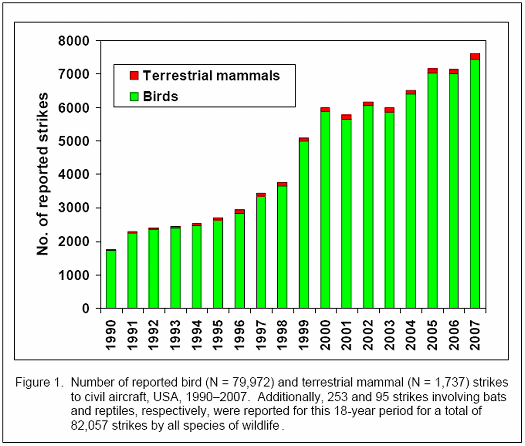|
|
|
|||||



|
Since 1990 the FAA has been compiling data about airplanes striking wildlife--mostly birds, but lots of other creatures as well--and wildlife striking airplanes. The data was for internal use only. But after the dramatic landing in the Hudson River a couple of months ago of an airplane which presumably lost all power after striking birds, pressure has been building for them to make the data public. The FAA's position was that if the data was public, some airlines and airports would feel pressure to minimize their reporting to avoid comparison. The view that has now prevailed is that releasing the information helps researchers who will be better able to address the problem, making it safer for everyone. In each incident, an attempt is made to accurately identify species, as well as many parameters: altitude, time of day, speed, etc. Statistics lump Commercial, Military and General Aviation. Since 1990 the annual total of reported incidents has gone from fewer than 2,000 to around 8,000, but that cannot be taken to accurately reflect what's going on. The numbers probably reflect an increase in rigorous reporting during that time period, as well as a continual increase in flight operations. The database shows a total of more than 89,000 incidents since 1990, and 28 cases since 2000 when a collision with a bird or other animal was so serious that the aircraft was considered destroyed.  One fascinating thought is that global warming has resulted in once-migratory bird species now wintering over. A lot of their grazing is near airports--JFK in New York, for instance, is built in a marsh along Jamaica Bay--and so they're available to get hit by airplanes year-round. The 18 years of data is very nicely summarized here (a pdf file, requiring Adobe Reader). The database itself is on the FAA website at http://wildlife-mitigation.tc.faa.gov/public_html/index.html#access and can provide a great deal of browsing pleasure. It's not just birds, although once the airplane has left the ground, that's what it is going to be. But on the ground there have been reported incidents with alligators, turtles and even caribou. Charlottesville Airport has reported 21 interactions since 1990, five of which resulted in damage to the aircraft, with no injuries to people. All with birds, mostly small, with no particular pattern discernable-- none from 2003 to 2007, then four in 2007, one report from last August and nothing since. While the Shenandoah Valley Regional Airport, during the entire period, has just one report--of birds being struck during takeoff, with no damage to the plane. (Dave Sagarin, April 24, 2009)
|
